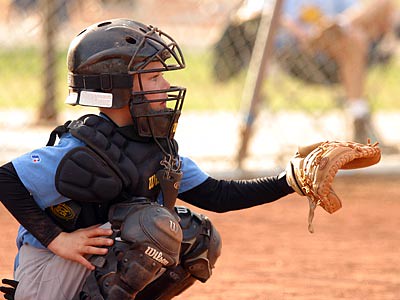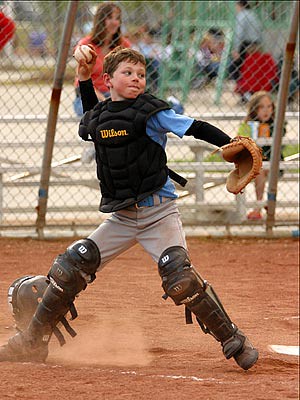I have found the best time to get photos of the catcher is during the first inning warmups. This is when the pitcher goes out and finishes warming up his arm and throws up to a dozen pitches at game speed. There is no batter, no umpire. Just the pitcher and his catcher.
There are three specific things I look for when taking pictures of the catcher during warmups. First, I want to get close enough to get a good, tight shot of just his upper body and extended glove while he waits for a pitch. This should give a pretty good view of his face through the face mask, and isolates the photo to just him. Like this shot.

Second, I also look for a shot of him making the throw to second base, as if a runner was trying to steal. This throw is usually announced before the pitch by the catcher yelling out "Coming down!"

Third, I try to get any shot of him with his helmet and mask in his hand and his face exposed. These can be unpredictable and hard to catch, so be on the lookout at all times for these when shooting catchers. Mothers just love that kind of shot because it shows their favorite player in a position that definitely speaks 'catcher' but the face is easy to see, like this.

Finally, just a few more pointers about shooting catchers.
- Position yourself so his body opens up to you when catching and throwing. That means shoot from the first base line for a right-handed catcher, and vice-versa for a lefty.
- In youth sports, using a 70-200mm lens (or something similar) will give you enough range to shoot from the dugout area or near the coach's box. High school and higher level baseball will usually need something with more reach, like a 300mm lens.
- Get down on their level. If they are crouching, then you need to crouch. If they are standing up to make a throw, then you can stand up.
- And the most important thing is to always ask the umpires for permission to step out onto the field of play. This applies for foul territory, too! What I usually do is show up before the game starts and ask the umpires while the two teams are warming up. I will talk more about this tomorrow.





No comments:
Post a Comment